SOLD
1950-1960 Vintage Lot of Patch and Darning French Chore Work Worker “GRIS de Travail” Coat
もともとは働く人たちにとっての上っ張りとして、 汚れの防止や機能性だけを考えて作られたはずのワークコート。 しかしフランスで作られた物は、 実用一点張りで無骨な物が大半の英国やアメリカの物とは 趣の異なる素材感やシルエットと 機能性を重視しながらも、そこかしこに散りばめられた フランスの粋と機能的装飾デザインの素晴らしさから 現代にも通用する別格のものを確立させています。 Work coats were originally designed to be used as a top for working people, to prevent stains, and to be functional. However, those made in France have established something exceptional that can be used in the modern age from the splendor of French style and functional decorative design scattered here and there, while emphasizing functionality and a different sense of material and silhouette from those in England and America, where most of the items are practical and rugged.
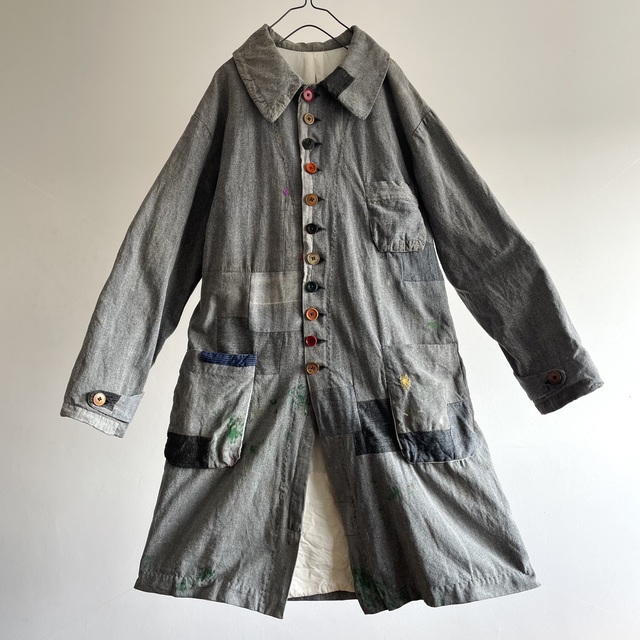

緯糸がブラックで経糸が白と黒のメランジ糸で織られ、白色と黒色が入り混じった色合いの生地からフランスで、“GRIS de Travail” (グレーの仕事着)と呼ばれるワークウエア。
This workwear is called “GRIS de Travail” (gray workwear) in France because of its mixed color of white and black, woven with black weft yarn and black and white warp yarn melange.



1950年代に作られたこのコートも大きなポケットや、ゆったりした分量など、作業時のオーバーコートとしての機能を果たしながらも、背中のベルトのような装飾的なデザインや、立体的な造形など単なる労働着を超えた意匠に満ちています。
This coat made in the 1950s also fulfills the function of an overcoat for work with its large pockets and loose volume, but it is filled with designs that go beyond mere work clothes, such as decorative designs like the belt on the back and three-dimensional modeling.



戦後、経済的に疲弊しきっていたフランスの復興を支えた労働者たちの仕事着です。着込まれて薄いグレーに進化し、経てきた時間を映す水墨画のような陰影とふくよかな皺は、決して加工では再現できない創造性を持っています。
These were the work clothes of the workers who supported the reconstruction of France after the war, when the country was in the throes of economic exhaustion. They have evolved into a light gray color through wear, and the ink-painting-like shading and plump wrinkles that reflect the time that has passed have a creativity that can never be reproduced by processing.


ワークコートは働く人たちにとっての上っ張りとして、 汚れの防止や機能性の求めに応じて作られました。
その証拠に米国や英国のものは、頑丈な素材を使い2重3重のステッチが入った直線的なディティールで、縫製効率や生地要尺の節減、意匠よりも機能優先の基本にしたがった頑丈で無骨な物が殆どです。
Work coats were made to serve as a top for working people, to protect them from dirt and to meet their functional needs.
Evidence of this is that most American and British coats are made of sturdy materials and have linear detailing with double and triple stitching, and are sturdy and rugged according to the basic principle of prioritizing function over sewing efficiency, fabric saving, and design.

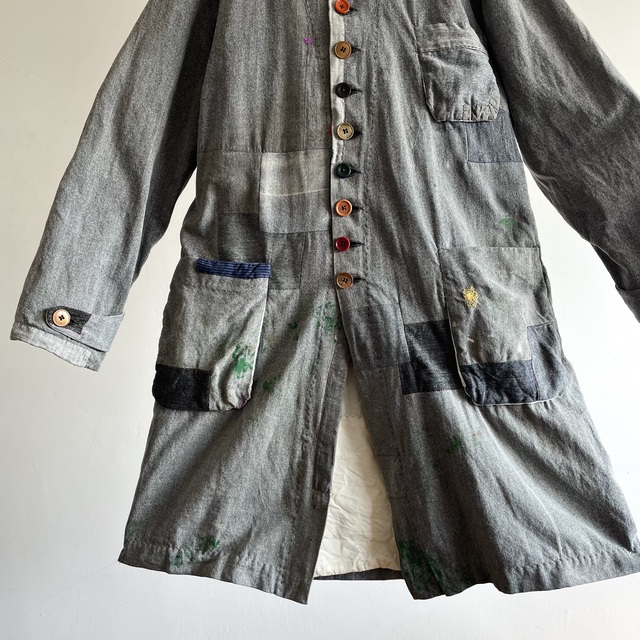
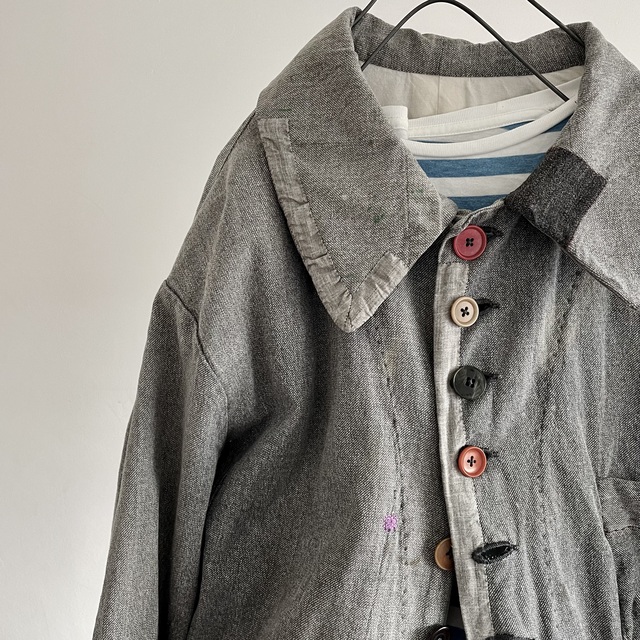
少し大きめのポケット。一度解体し、ダメージを古いリネン生地などで補修した後に、裏に生地を縫い合わせ、それをもう一度手で内縫いすることで縁を浮かせて立体的に再表現。ぷっくりとしたフォルムと、縁から覗く裏地の生成りが軽さと動きを与えます。
Slightly larger pockets. Once disassembled, the damage was repaired with old linen fabric and other materials, and then the fabric was sewn to the back, which was then internally sewn by hand once again to float the edges and re-express them three-dimensionally. The puffy form and the raw lining that peeks out from the edges give it lightness and movement.


経てきた長い時間を取り込んだ風合いと、着込まれた涸れた色合いが深みを加え、愛用のしるしのダメージが辿ってきた時間を色濃く映し出しています。
The texture of the garment has taken in a long time, and the dry color of the garment adds depth, and the damage that shows the signs of love reflects the time that has passed.
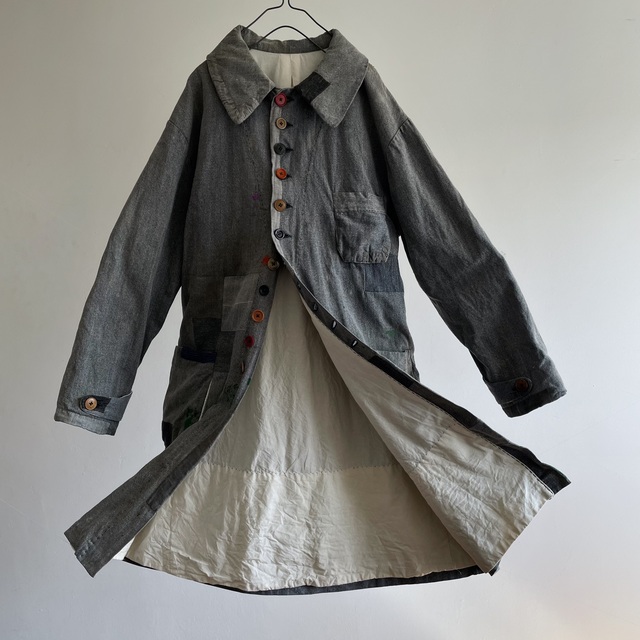


このころのフランスの仕事着によく見られる、衿を1枚で作らずに強くカーブした2枚のパーツを継いだ、身頃に沿う形のフラットながらもボリュームのある衿。この衿も立体的なパターン発想が作り出したフランスならではのもの。
The collar, often seen in French workwear of this period, is not made of a single piece but is made of two strongly curved parts that are joined together to form a flat but voluminous collar that follows the body. This collar is also a uniquely French creation of a three-dimensional pattern conception.



インディアインク染のリネンで作り変えた裏襟。ステッチと身頃へ止め付けるハンドステッチのレッドとのコントラスト。
Back collar made of India ink-dyed linen. The contrast between the stitching and the red of the hand stitching on the body.
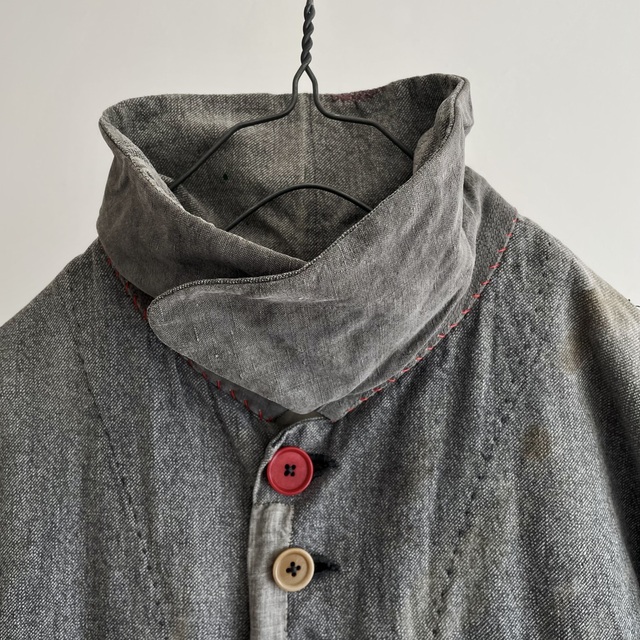
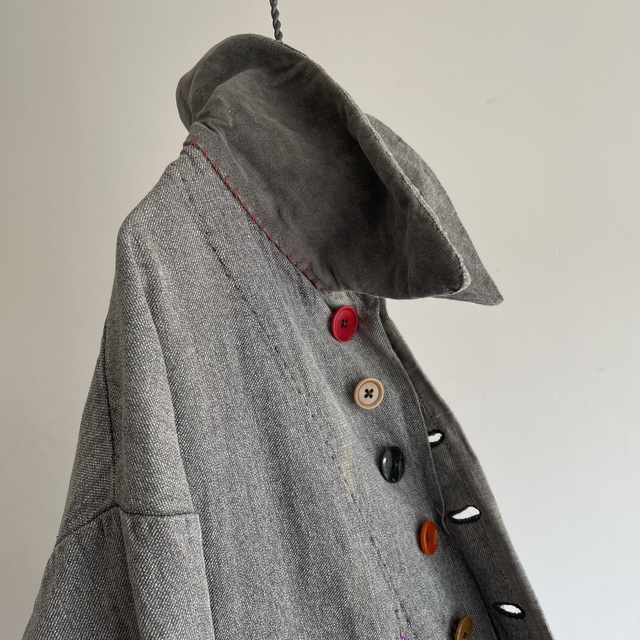

ボタンはさまざま色と形のの2種類のサイズをランダムにチョイスした、vintageのcorozo(主にエクアドルのタグワ椰子)。その実の種子の中の胚乳部分を加工して作られた趣のあるボタン。
The buttons are vintage corozo (mainly Ecuadorian tagua palms) in two randomly selected sizes of various colors and shapes. The buttons are made from the endosperm inside the seed of the corozoan palm, which is a vintage corozo (mainly Ecuadorian tagua palm).



19世紀から1950年代のプラスティック開発以前に、滑らかな手触りと硬さ丈夫さ染色性の良さを利用して、盛んに作られていたボタン。
Before the development of plastics in the 19th century through the 1950s, buttons were actively made to take advantage of their smooth feel, hardness, sturdiness, and dyeability.


vegetable ivoryの呼び名通りの乳白色の実を削って加工される何とも言えない丸みと、乳白色のベースを染める事で生まれる優しい色合いの魅力。見た目に反してしっかりした質感と重みを兼ね備えた、味わい深さを持ったボタンです。
As the name “vegetable ivory” implies, this button has an indescribable roundness created by shaving milky white berries, and the charm of the gentle coloring produced by dyeing the milky white base. Contrary to its appearance, this button has a solid texture and weight, and has a deep sense of taste.



元からあったボタンホールも糸を解き、全て手縫でステッチし直したハンドホールです。数を3倍に増やしたボタンが作り出す普通のようで普通ではない表情。
The original buttonholes are also hand-holed, with all the threads untied and re-stitched by hand.
The buttons, whose number has been tripled, create an ordinary but unusual look.

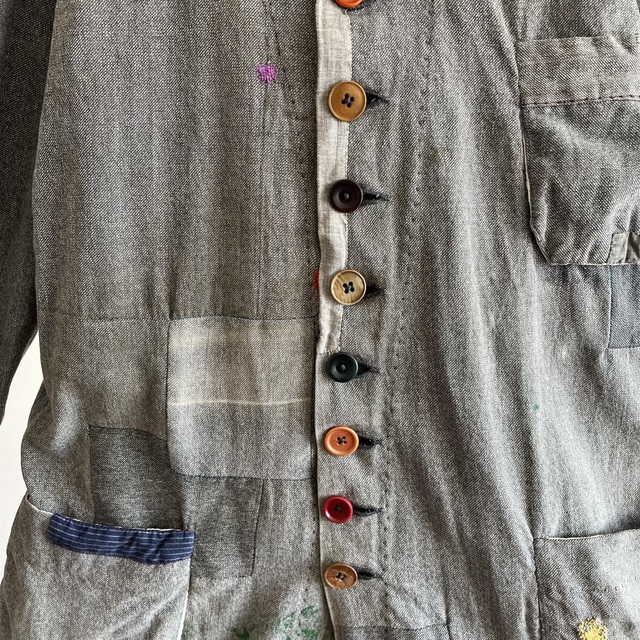
ハンドステッチでのライニング。手の温もりではなくストイックさを伝える不揃いなステッチ、縫い皺の表情や生地のコントラストが乾いた奥行きを作り出します。
Lining with hand stitching. Uneven stitching that conveys stoicism instead of hand warmth, the expression of stitch wrinkles and fabric contrast create a dry depth.
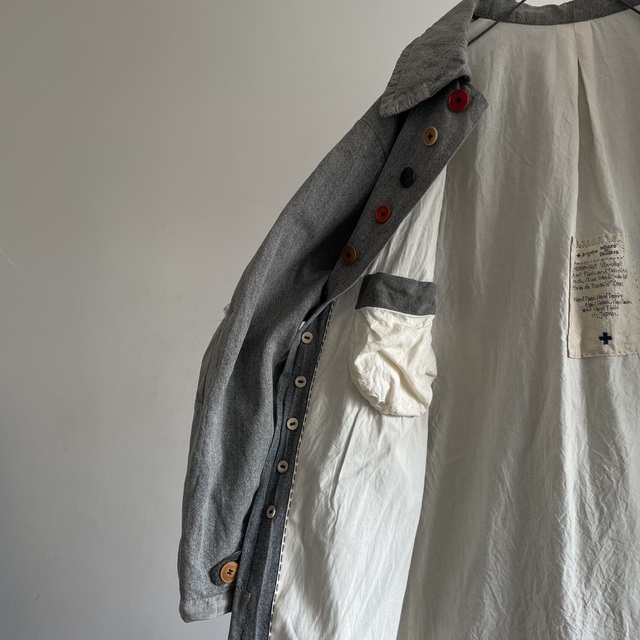


適度な厚みのある未晒しの素朴な風合いとしわが魅力の、インドで織られた生地のライニングは、表地とのコントラストと清潔感を作り出してくれます。
The lining, woven in India, has a rustic texture and wrinkle charm of unbleached fabric of moderate thickness, creating a contrast with the outer fabric and a sense of cleanliness.



ミシンで縫えば数分の仕事に、その十数倍の時間をかけたことの意味は、きっとあるはず。
Blind stitching by hand to sew the linings together. It must be meaningful that we spent more than ten times as much time on a job that would take only a few minutes if sewn with a sewing machine.



ヘムを軽くするために、止めつけずに浮かせてつけたライニングの裾。適度なボリュームを持たせるために深い見返しをつけ、ハンドステッチでアクセントを添えています。
To lighten the hem, the lining hem is floated instead of sewn. A deep turnover is added to give the right amount of volume, and hand-stitched accents are added.


「汚れが目立たない」という理由だけで採用されたのだとは信じられないほど完成された色合いと風合い。
“The color and texture are so perfect that it’s hard to believe that it was adopted just because it doesn’t show dirt.



着込んでいくことで進化した時間を映す水墨画のような陰影は、これからもますます深い姿となる日が楽しみを秘めています。
I look forward to the day when the shade like ink painting reflecting the time evolved by wearing it will become deeper and deeper in the future.


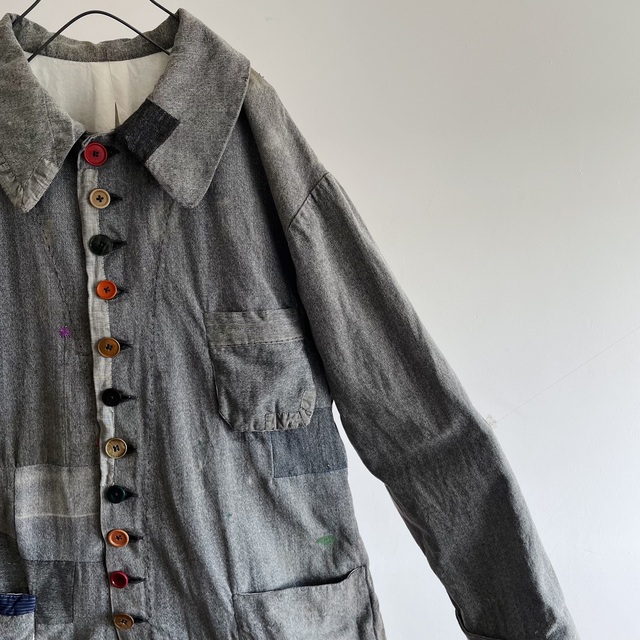
テーラーワークを基本としたパターンメイクと縫製が、「 ファッション 」 と対極の位置にあるはずの「仕事着」を、様々なメゾンやデザイナーがモデルとする高みに今も位置付けます。
Patternmaking and sewing based on tailor’s work positions “work clothes”, which should be the opposite of “fashion”, at the height that various maisons and designers use as a model.
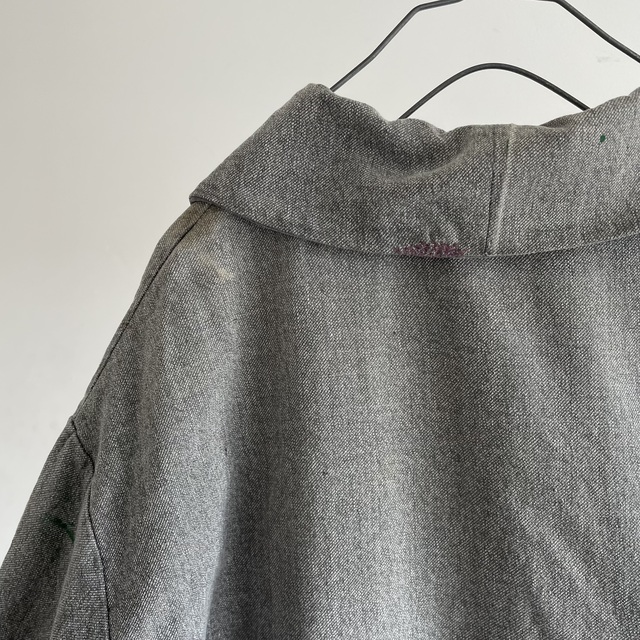

ファッションとは無縁のはずの世界である仕事着に込められた、フランスのセンスが、多くの愛好家を生み、惹きつけ続け、お手本となり続ける、フランスというモード発祥の地が培った“ ファッションの原点 ” が生み出したワークウェアの到達点の一つです。
The French esprit and sense put into workwear, which is a world that should have nothing to do with fashion, has given birth to many lovers and continues to attract them, and continues to be a role model. It is one of the achievements of workwear.

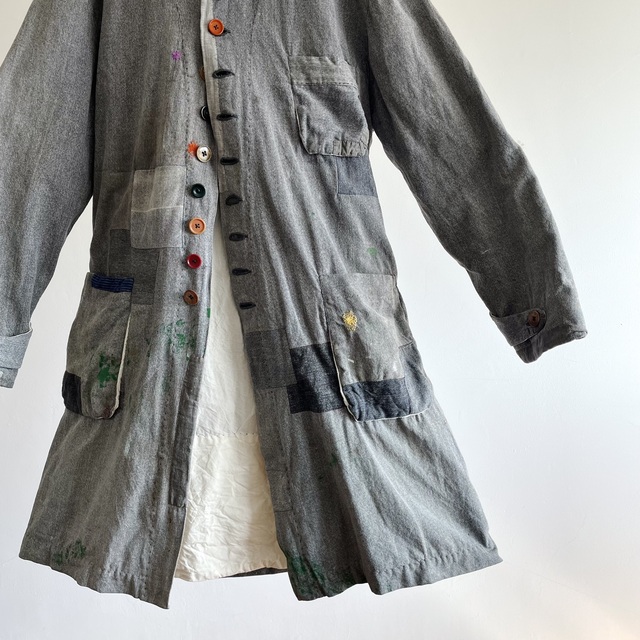

サイズ 2
肩幅 =52cm
バスト=60cm(脇下)
袖丈 =60 cm
着丈 =103cm
フランス/日本製
Front Fabric = French Grayish MelangeTwill / Cotton 100%
Back Fabric = Indian Rustic Cotton Broad Cloth / Cotton 100%
Buttons = 1950-1960 Vintage French Corozo Button
& Antique Fabric Covered Button
STOREへのリンク
1950-1960 Vintage Lot of Patch and Darning French Chore Work Worker “GRIS de Travail” Coat
[ALTERATION By Manure Of Drawers] SOLD

